Menu
William Gibson
William Gibson, the visionary author renowned for coining the term “cyberspace” and predating the existence of both the Internet and virtual reality in his works, has left an indelible mark on the realm of science fiction. His literary contributions include iconic titles like “Neuromancer,” “Count Zero,” “Mona Lisa Overdrive,” “Burning Chrome,” “Virtual Light,” “Idoru,” “All Tomorrow’s Parties,” “Pattern Recognition,” “Spook Country,” “Zero History,” “Distrust That Particular Flavor,” and “The Peripheral.” Currently residing in Vancouver, British Columbia, he shares his life with his wife.
The Sprawl Trilogy
William Gibson’s Sprawl Trilogy, The birth of Cyberpunk. These books are prescient, defining what our future will look like with a high degree of accuracy. It’s for this reason that I became interested in reading anything I could get my hands on by Gibson. The Sprawl Trilogy is about innovative technology, vivid fantasy, and thought-provoking social commentary, all brilliantly combined in this groundbreaking series. Here, Gibson will explore how art, science, and technology can work together in a fluid way.
Neuromancer:
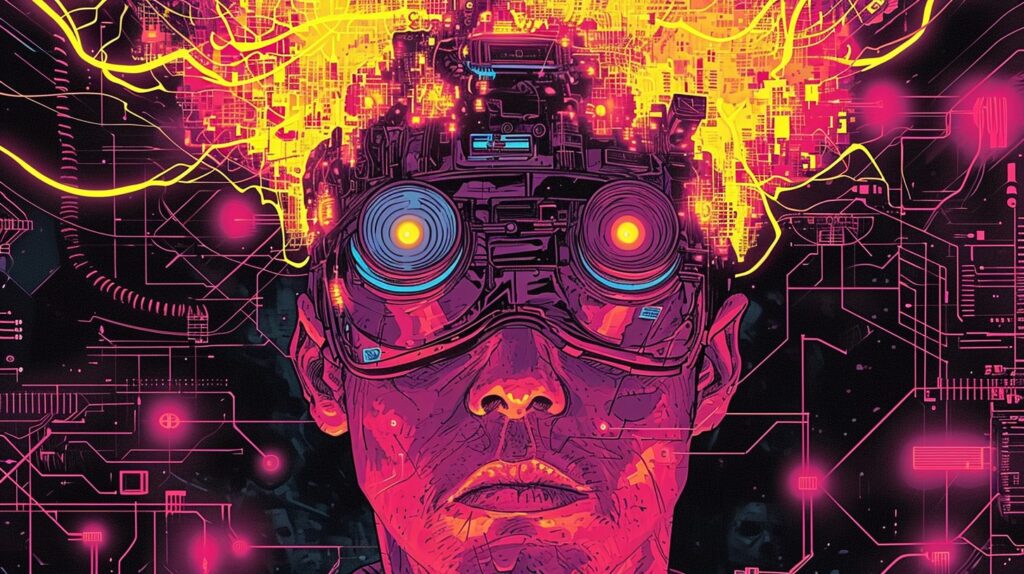
“Neuromancer,” released in 1984, is like a mind-bending journey into the future that you never want to end. Every time I revisit this cyberpunk masterpiece, it’s as if I’m peeling back the layers of a digital onion, discovering something new and exhilarating with each read.
The story follows Case, a failed computer hacker with a difficult past, is given a second chance when he is hired to carry out a dangerous heist involving a powerful AI. He is really cool, but his partner, Molly, is a robotic badass who takes things to a whole new level. The streets are lit up with neon signs, and cyberspace is a virtual world. Gibson creates a world that is both thrillingly futuristic and strangely predictive.
Aside from its fast-paced story, what makes “Neuromancer” unique is Gibson’s skill at capturing the spirit of a world where people and technology are not so different. He doesn’t just give a picture of tools and gizmos; he looks into the heart of a digital society. He is truly imaginative in the way he explains the idea of “cyberspace” and how addicting the virtual world can be.
Beyond the technical magic, “Neuromancer” gets to the heart of what it means to be human in a time when there is too much information and too much corporate power. It makes us think about what it means to live in a world where data is king and hackers are the outlaws of the digital frontier.
In a nutshell, if you’re seeking a sci-fi adventure that not only entertains but also challenges your perception of the future, “Neuromancer” is the book to pick up. It’s a timeless classic that continues to resonate with its gritty, cyberpunk charm and thought-provoking themes. So, grab a copy, immerse yourself in the neon-soaked world of William Gibson, and prepare to have your mind blown.
Count Zero:
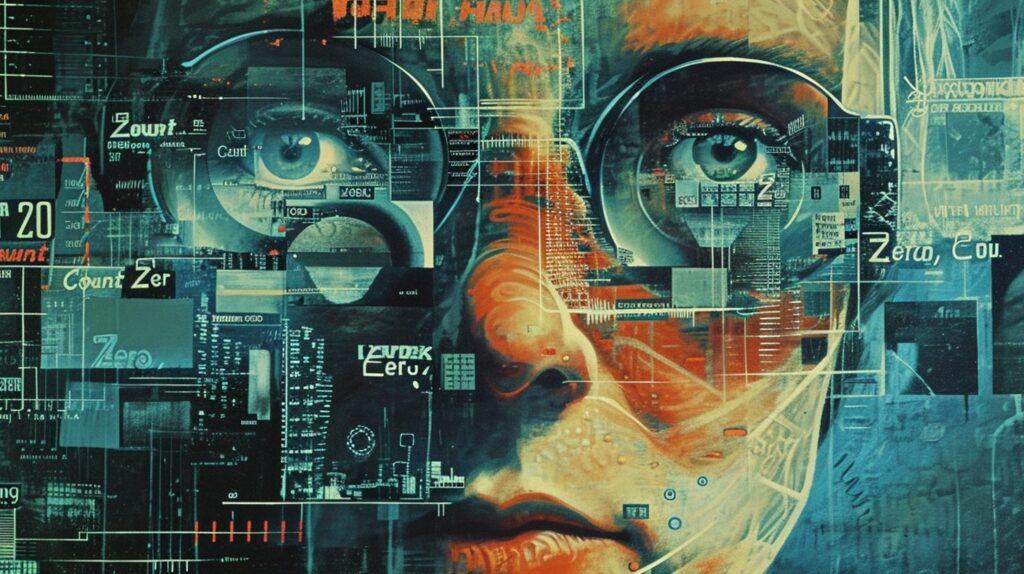
The story has a new lead character: Bobby Newmark, who is also known as “Count Zero” in the hacking world. Imagine a world run by huge corporations where information is the most important thing. Similar to the last book, the future is bright and full of technology. Even so, “Count Zero” isn’t by himself. He is working with Turner, a former fighter who now works as a corporate assassin, on a mission that could have global effects.
The quality of Gibson’s worldbuilding is what elevates “Count Zero” above its predecessor. It’s simple for him to expand on the universe he created in “Neuromancer,” incorporating new viewpoints and characters while preserving the cyberpunk atmosphere. The book examines corporate power dynamics, the evolving field of artificial intelligence, and the blurring of boundaries between the physical and virtual worlds.
Gibson’s writing is as sharp as ever, and his storytelling skills are on full display as he weaves together several plots, each with its own unique mix of mystery and tension.
In “Count Zero,” Gibson not only delves deeper into the cyberpunk universe he has built, but he also challenges us to consider what it means to live in a society where knowledge is the most potent weapon. This novel will keep you on the edge of your seat and remind us that the human spirit is still a powerful force, even though technology may govern the future.
“Count Zero” is a must-read for fans of “Neuromancer” or for anybody looking for a cerebral cyberpunk adventure. With intriguing people and thought-provoking concepts, it’s a thrilling addition to Gibson’s trilogy about a computerized future. Get a copy by going here. Prepare to enter the virtual world, then, and have an experience that will leave you wanting more.
Mona Lisa Overdrive:
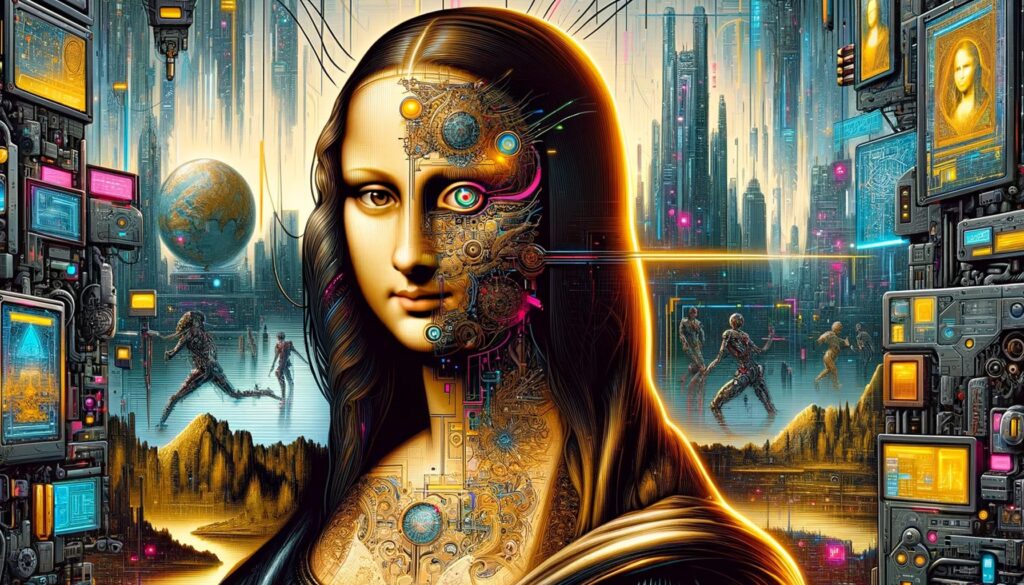
“Mona Lisa Overdrive” (1988) neatly ties up William Gibson’s “Sprawl Trilogy.” As the concluding chapter, it brings together characters from the previous two books while introducing fresh faces like Mona and Kumiko. In this cyberpunk adventure, Gibson dives deep into the realm of artificial intelligence, exploring the complex relationship between humans and machines.
Gibson’s writing retains its signature mystery while deftly fusing high-tech components with a story that makes it difficult to tell the difference between the virtual and the actual world. It’s an engaging approach that doesn’t get in the way.
One of the highlights of “Mona Lisa Overdrive” is how it connects the dots between characters we’ve grown to know and newcomers to the series. Whether you’ve been following the enigmatic Case and the fearless Molly or are meeting Mona and Kumiko for the first time, their stories intertwine in a world dominated by technology and corporate power.
This book is unique because it explores consciousness and identity in a way that is thought-provoking, especially in a world where lines between technology and people are becoming increasingly hazy. It invites readers to consider what happens when society becomes more and more influenced by technological breakthroughs.
“Mona Lisa Overdrive” is a fitting wrap-up for the “Sprawl Trilogy.” It keeps the series’ distinctive combination of engrossing storyline and cyberpunk Æsthetic. If you’ve followed Gibson on this trip, this book brings everything together and offers new insights. It’s a great way to get started if you’re new to the series and want to explore the world of high-tech intrigue and hazy realities. Get a copy now, and allow “Mona Lisa Overdrive” to transport you on a fascinating journey across the digital frontier.
Bridge Trilogy
The Bridge Trilogy is a collection of three provocative books that vividly depict a society formed by corporate power, technology, and the enduring human spirit. Here, the San Francisco Bay Bridge has been colonized by the down trodden who have no other place to live, converting it in to a sort of favela. This is the launching point for the Bridge Trilogy.
Virtual Light:
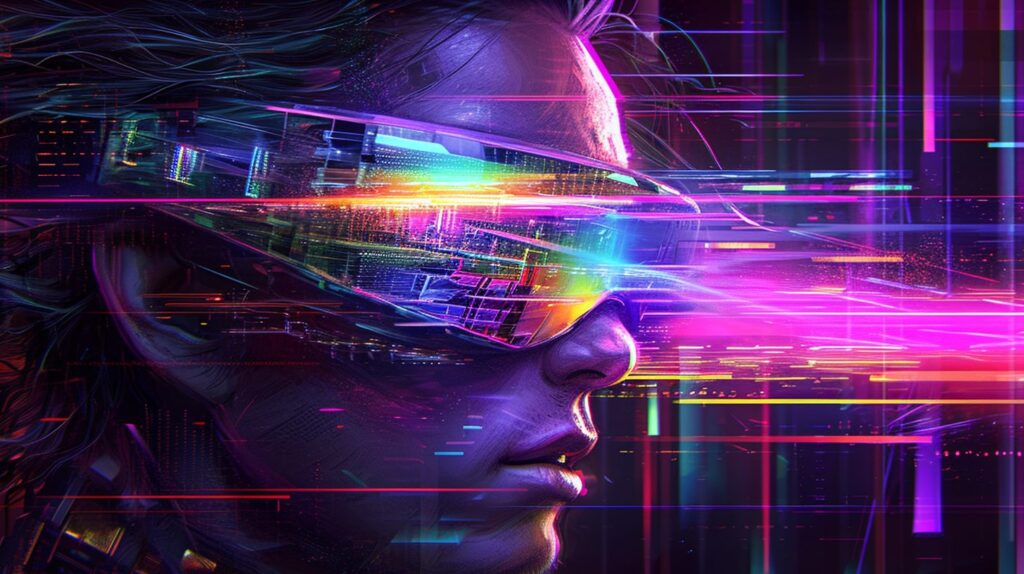
“Virtual Light” (1993), readers are taken to an intriguing future that is both uncannily identical and tantalizingly futuristic. It presents Gibson’s signature blend of cutting-edge technology and societal commentary.
The story revolves around the lives of Berry Rydell and Chevette Washington, two individuals whose paths meet in a society on the edge of chaos. The story takes place in post-catastrophic California. The concept of “virtual light,” a kind of augmented reality that existed before our current understanding of virtual worlds, is presented in the novel. Because of how much the story depends on this technology, it becomes hard to tell what is synthetic and what is genuine.
It depicts a realistic image of a not-too-distant future when socioeconomic inequalities are prominent and mega-corporations have significant power. “Virtual Light” stands apart. Gibson’s skill at world-building is on display as he paints a grim yet inexplicably alluring picture of this future California.
In-depth discussions of surveillance, urban decay, and the effects of unchecked corporate control are also included in the text. It is a contemplation of the potential risks associated with our rapidly developing technology and how it affects both our personal lives and society at large.
Ultimately, “Virtual Light” showcases his mastery of the genre. Readers are prompted to contemplate the implications of our rapidly evolving technological landscape by this perceptive look at a future that feels disturbingly close. If you like a well-crafted story, detailed world-building, and a healthy dose of social critique, “Virtual Light” ought to be on your reading list.
Idoru:
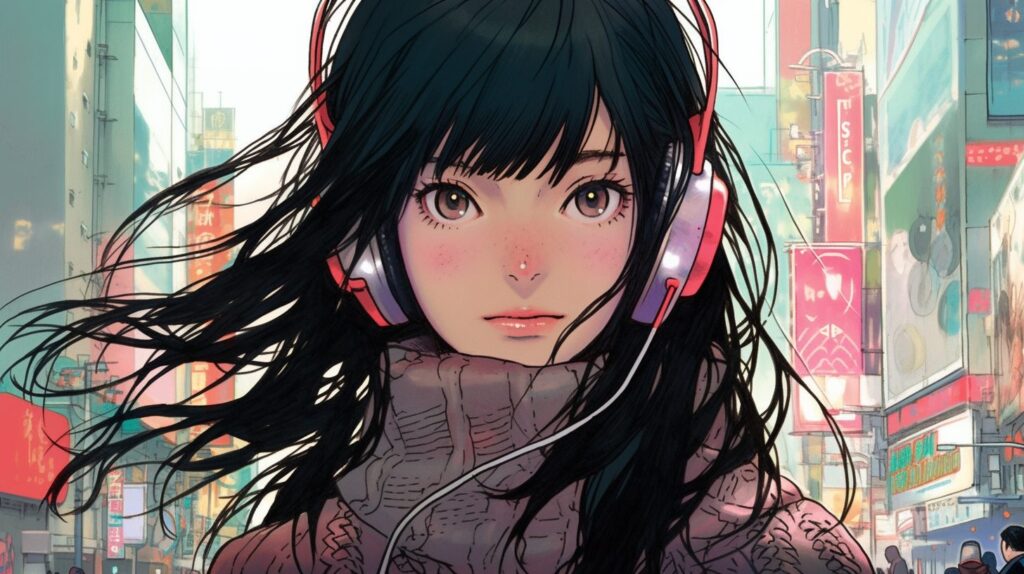
“Idoru” (1996) is a mesmerizing journey into the near-future streets of Tokyo. It’s a thought-provoking exploration of the intersection between technology, celebrity culture, and the enigmatic allure of the artificial.
Two main characters are introduced to us in this novel: Rez, a rock star who wins over followers all over the world, and Chia, a teenage fan who is drawn into an intriguing journey. Their paths eventually cross because they both develop an obsession with Rei Toei, an idoru—a virtual artificial intelligence superstar. Their fixation thrusts them into a realm where the lines separating the virtual and the real are blurred, raising important questions about what defines true fame and truth.
Gibson’s writing in “Idoru” is nothing short of poetic. He creates a vibrant portrayal of Tokyo, a city brimming with neon, technology, and a feeling of continual change. His style is as vivid as ever, transporting the reader to a world that is both tantalizingly familiar and fascinatingly unfamiliar.
What distinguishes “Idoru” is its investigation of the influence of technology on celebrities and their sense of reality. It highlights concerns about stardom, the appeal of artificiality, and the ever-changing connection between humans and robots. Gibson encourages us to consider how our culture is increasingly influenced by the digital and virtual.
“Idoru” is a cyberpunk masterwork that continues to attract readers with its combination of high-tech mystery and social satire. It serves as a reminder of technology’s ever-expanding importance in our lives, as well as its impact on our notions of celebrity, reality, and personal connection. If you’re seeking a thought-provoking and engrossing voyage into the future, “Idoru” should be on your must-read list.
All Tomorrow's Parties:

“All Tomorrow’s Parties,” is a riveting addition to Gibson’s body of work, providing a view into a universe that is both enthralling and disturbingly familiar.
The plot develops with the planet on the verge of social breakdown, set in the not-too-distant future. The story focuses on a wide ensemble of people, including Laney, a data analyst with a special ability for seeing patterns in the digital chaos of information overload. As the tale progresses, we are lured into a web of corporate intrigues, and the enigmatic entity known as “the nodal points.”
What distinguishes this work is its examination of the effects of information overload and the power that data exerts in our lives. It invites readers to consider the ramifications of living in a culture in which information is both a weapon and a currency, and the digital sphere has become an extension of our own selves.
“All Tomorrow’s Parties” is a compelling contribution to William Gibson’s body of work. It demonstrates his ability to deconstruct the complexity of our digital world while writing a fascinating story full of mystery and tension. If you enjoy cyberpunk literature that questions your assumptions about technology and society, this work is a must-read. Gibson once again urges us to confront the shadows of our future, where knowledge is power and the distinction between reality and the virtual is anything but obvious.
The Blue Ant Trilogy
The “Blue Ant Trilogy” This trilogy varies from Gibson’s earlier cyberpunk settings, transporting readers to a world of modern technology, corporate intrigue, and cultural analysis. The enigmatic advertising agency Blue Ant serves as a focal point for the characters’ interactions with the ever-changing digital environment, tying these stories together. Each volume of the trilogy is a unique inquiry into the intersection of technology, art, and society in today’s world.
Pattern Recognition:
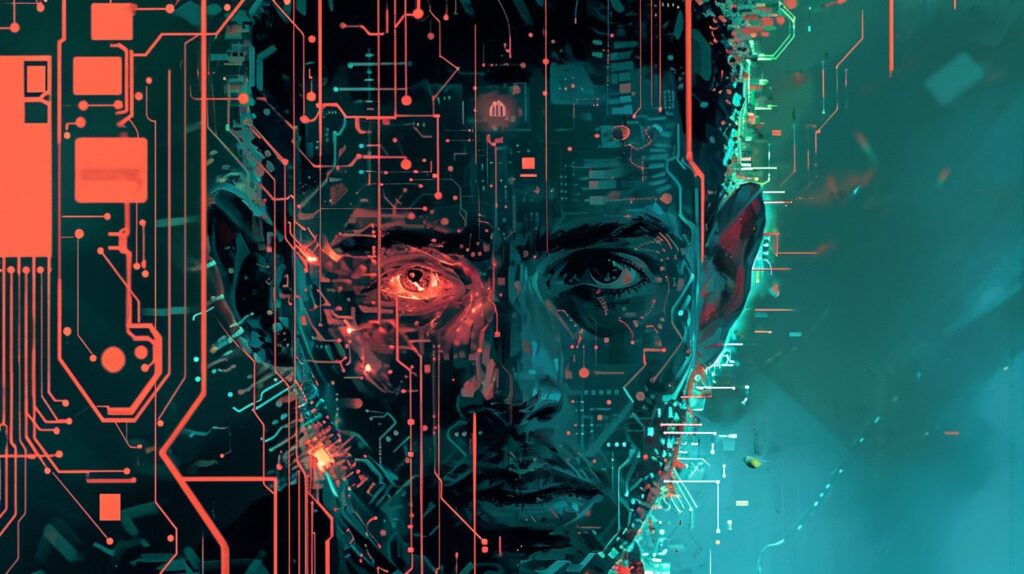
“Pattern Recognition” The novel, published in 2003, follows Cayce Pollard through a world of global branding and intriguing computer conspiracies.
Cayce is smart and enigmatic, with a one-of-a-kind ability to recognize the worth and validity of cultural trends. This talent propels her into the high-stakes world of advertising, where her expertise becomes a valuable commodity. In this realm, Cayce discovers a clandestine network of people who share her passion for deciphering and unraveling the mysteries of these conspiracies.
One of the novel’s highlights is its examination of how the digital world affects our lives. It dives into topics including online communities, the power of the internet, and the ubiquitous effect of branding and marketing. “Pattern Recognition” is fundamentally about the human drive to identify patterns and meaning in an increasingly linked environment.
“Pattern Recognition” is a superb blend of modern fiction and technology that highlights William Gibson’s exceptional narrative abilities. It’s a thought-provoking voyage through the complexities of our digital world, led by an engaging protagonist and written in Gibson’s signature style. If you’re interested in the interplay of technology, culture, and identity, this novel is a must-read. It invites you to unravel the patterns that characterize our modern society.
Spook Country:

“Spook Country” (2007) is a thought-provoking look at the ever-changing worlds of technology, espionage, and international intrigue. It’s a work that blends elements of espionage, cyberpunk, and modern fiction to create a tale that is both timely and unique.
The story is set in a post-9/11 society where distrust and surveillance are ubiquitous. Gibson introduces readers to a diverse assortment of characters, each with their own motivations and secrets. The plot focuses on Hollis Henry, a former musician turned journalist who becomes embroiled in a global web of intrigue.
Gibson’s writing in “Spook Country” is as sharp as ever, with his trademark ability to paint a vivid picture of a world where technology and espionage collide. His writing is vibrant, taking readers to a world where the digital and physical are inextricably linked.
What differentiates “Spook Country” is its ability to captivate readers in a gripping tale while also challenging them to examine the implications of our interconnected world. It’s a novel that asks us to explore the invisible forces that shape our world, making it both an intriguing read and a thought-provoking examination of our day.
“Spook Country” is a fantastic addition to William Gibson’s body of work, showcasing his ability to craft a narrative that is both socially significant and intellectually difficult. If you appreciate tales about technological sophistication, espionage, and global intrigue, this one is a must-read. It invites you to embark on a journey where digital and analog collide, and the distinction between reality and the virtual world is anything but apparent.
Zero History:

“Zero History” (2010) is the exhilarating conclusion to his Blue Ant Trilogy, which has looked into the intersection of technology, art, and culture in the modern world. The novel, published in 2010, showcases Gibson’s expertise at combining cutting-edge technology with a complex story.
The narrative revolves around Hollis Henry, a former rock star turned journalist, and her quest to uncover the truth about Gabriel Hounds, a mystery fashion firm. This search leads her into the high-stakes world of global fashion, where trends are manipulated and authenticity is a coveted commodity.
Gibson expertly navigates the labyrinth of the fashion industry, revealing invisible influences that shape our culture. His work is engaging and thought-provoking, bringing the worlds of fashion and branding to life.
In “Zero History,” Gibson challenges us to assess the authenticity of our experiences in a culture dominated by branding and marketing. It’s a narrative that asks readers to contemplate the factors that shape our wants and perceptions in an era where the line between reality and fiction is becoming increasingly blurred.
“Zero History” is a fitting conclusion to the Blue Ant Trilogy, offering a riveting investigation of the fashion industry and its impact on our culture. It’s a work that illustrates William Gibson’s ability to craft compelling and intriguing stories. If you’re interested in the intersection of technology, art, and culture, this book is a must-read. It encourages you to discover the hidden world of fashion and branding, where authenticity is a scarce and precious commodity.
Jackpot Trilogy
The Jackpot Trilogy embodies the spirit of exploration, collaboration, and intellectual curiosity that resonates deeply with my own passion for learning. These novels invite readers to engage with the profound questions and possibilities of our digital age, emphasizing the interconnectedness of technology, art, science, and society.
As I eagerly await the next chapter in this trilogy, I encourage fellow science fiction enthusiasts to join me in this adventure. William Gibson’s storytelling serves as both a mirror and a window into our ever-evolving world, prompting us to consider the consequences of our choices and the potential for innovation and collaboration in the face of complex challenges.
May your own journey through the Jackpot Trilogy inspire you to embrace the endless possibilities of learning, collaboration, and engagement with the dynamic intersection of technology, art, science, and society.
The Peripheral
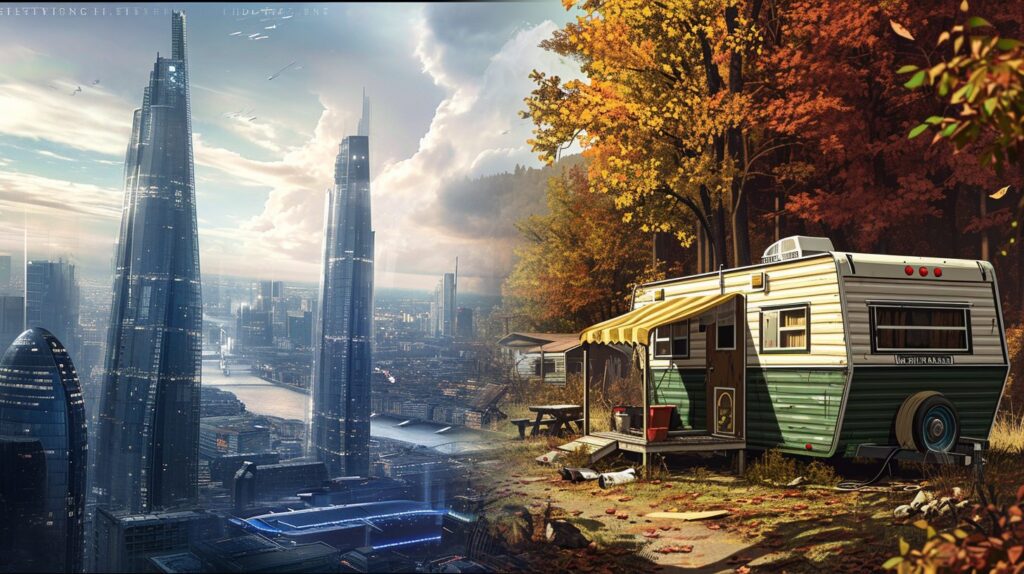
“The Peripheral” (2014): As I ventured into the pages of “The Peripheral,” I was immediately drawn into a multilayered narrative that defies the boundaries of time and reality. In one timeline, we encounter Flynne Fisher, a woman navigating a world on the brink of collapse, dubbed the “jackpot.” In another, the “peripheral,” digital avatars allow individuals from the past to interact with the future. This narrative duality challenges us to ponder the consequences of our choices, the impact of technology on society, and the intricacies of identity. The world-building in “The Peripheral” is a testament to Gibson’s ability to craft immersive and thought-provoking settings.
Agency

“Agency” (2020): The second installment, “Agency,” takes us deeper into the labyrinthine world of parallel timelines and artificial intelligence. In this novel, Verity Jane, an “app whisperer,” becomes entangled in a complex web of intrigue involving a sentient AI known as Eunice. As the story unfolds, we are invited to engage with the ethical and societal implications of AI, surveillance, and digital agency. “Agency” challenges us to reflect on the choices we make in an increasingly interconnected world, blurring the lines between the tangible and the virtual.
To Be Announced
I eagerly anticipate the release of the third installment in the Jackpot Trilogy. Gibson’s ability to provoke thought and stimulate curiosity in the realms of technology, art, science, and society leaves me eager to see where this journey will take us next.
Short Fiction
Burning Chrome
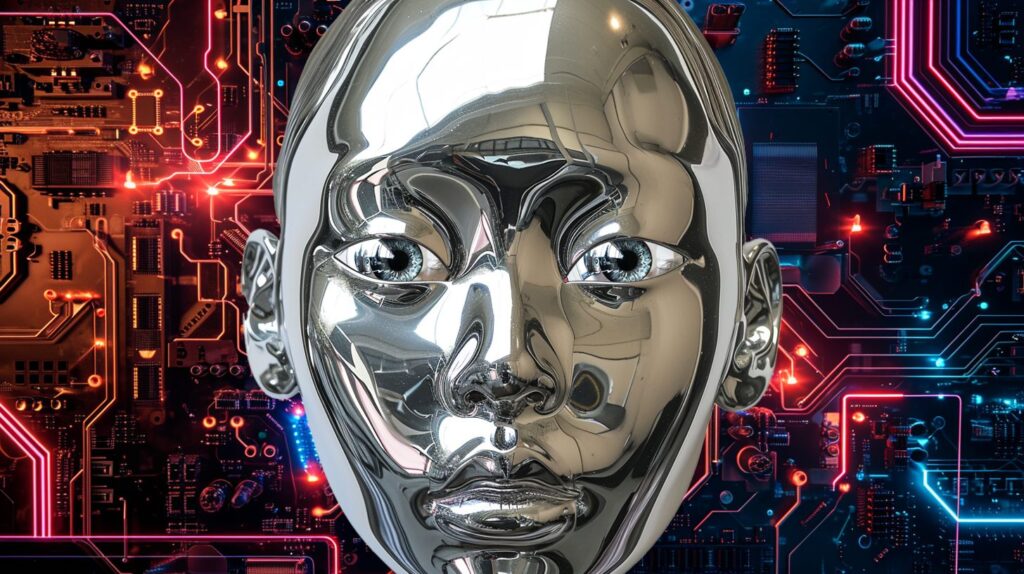
Embarking on a literary journey through William Gibson’s “Burning Chrome” collection of short stories has been a profoundly enlightening experience, mirroring the essence of my own ongoing journey of exploration and discovery. These stories, penned by the visionary architect of cyberpunk fiction, have the remarkable capacity to kindle an insatiable passion for learning, collaboration, and the intricate dance between technology, art, and the human spirit.
Published in 1986, “Burning Chrome” is a timeless anthology that invites readers to traverse a digital landscape where the lines between humanity and technology blur in thrilling ways. Under the expert guidance of Gibson’s visionary storytelling, we venture into a world inhabited by hackers, renegades, and those who navigate the labyrinthine underbelly of a society increasingly digitized.
One of the crown jewels in this collection is the titular story, “Burning Chrome.” It introduces us to Case, a once-promising hacker, and Molly, his enigmatic partner. Together, they embark on a daring heist involving a formidable AI, setting the stage for Gibson’s iconic novel, “Neuromancer.” In this narrative, we explore the enigmatic realm of the human-machine interface and the relentless pursuit of digital transcendence.
Gibson’s work in “Burning Chrome” extends far beyond mere storytelling; it serves as an open invitation to engage with the ever-evolving landscape of technology, art, and science. These stories challenge us to question the ethical implications of our digital age, inviting us to ponder the convergence of human consciousness and artificial intelligence and encouraging us to embark on our own intellectual odyssey in a world where the boundaries between fiction and reality are increasingly blurred.
Johnny Mnemonic

Another standout is “Johnny Mnemonic,” a cautionary tale that delves into the price of information overload in a world where data is the most coveted currency. As Johnny, a mnemonic courier, grapples with the consequences of memory augmentation, Gibson prompts us to reflect on the profound value of knowledge, the ethics surrounding data manipulation, and the sacrifices individuals make in a technologically driven society.